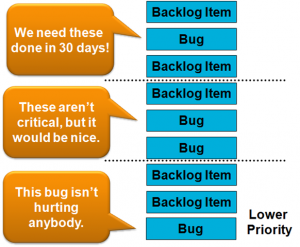Our company adopted scrum as our method for development over a year ago. And to this day, we’ve yet to get it entirely right. Over the months we’ve had to address issues ranging from “What do we do when critical issues come up?” to “Who should be a part of our daily scrum meeting?” to “What the hell is a story point anyway?” But one such problem that our Product owner recently brought up is, “Should we really be story pointing bugs?” And the answer, of course, is… well, actually, no one can really agree on an answer.
Well, let’s start out with why we all originally said yes. In any given sprint, our team will have to commit to some handful of stories and bugs off the top of the product backlog. If both the stories and bugs are story pointed to the same scale, then we have no problem deciding how much we can commit to this sprint given our previous velocities. And for a while, this worked fine.
But let’s look at this from the product owner’s point of view. Let’s say we’ve just released the next version of our product and now our product owner is looking over the backlog, trying to figure out how many sprints we’ll need to complete the required features (let’s say there are 10) we need for the next release. Each of these features gets defined as a story. For the sake of simplicity, let’s say they all have a story point value of 10, resulting in a total of 100 story points. In our past sprints, our velocity has averaged 20 story points. So our product owner can set the next release date for five sprints from now. Easy! Continue reading Scrum Debates: Story Pointing Bugs
